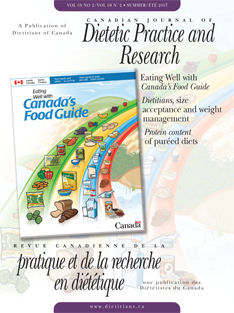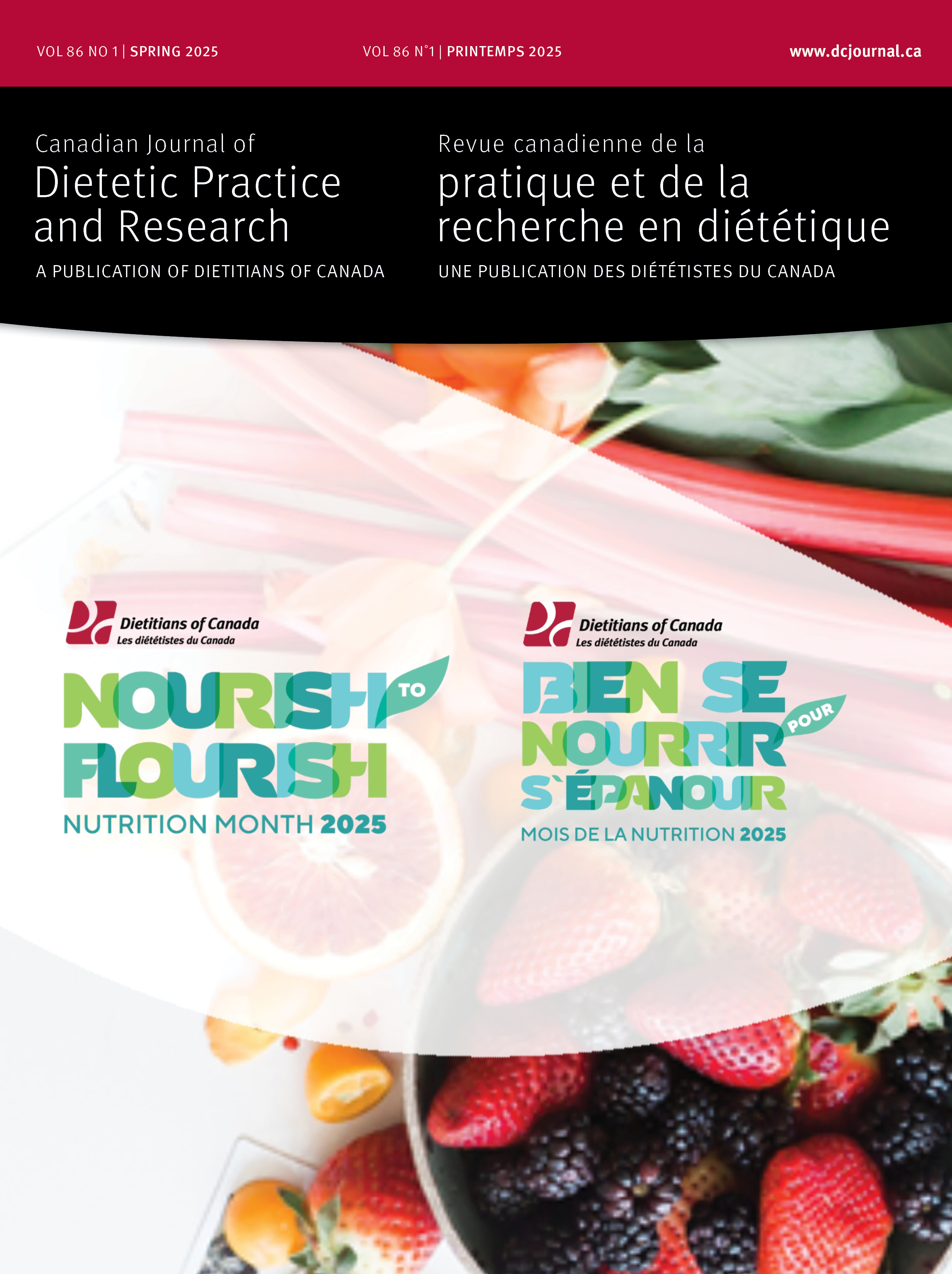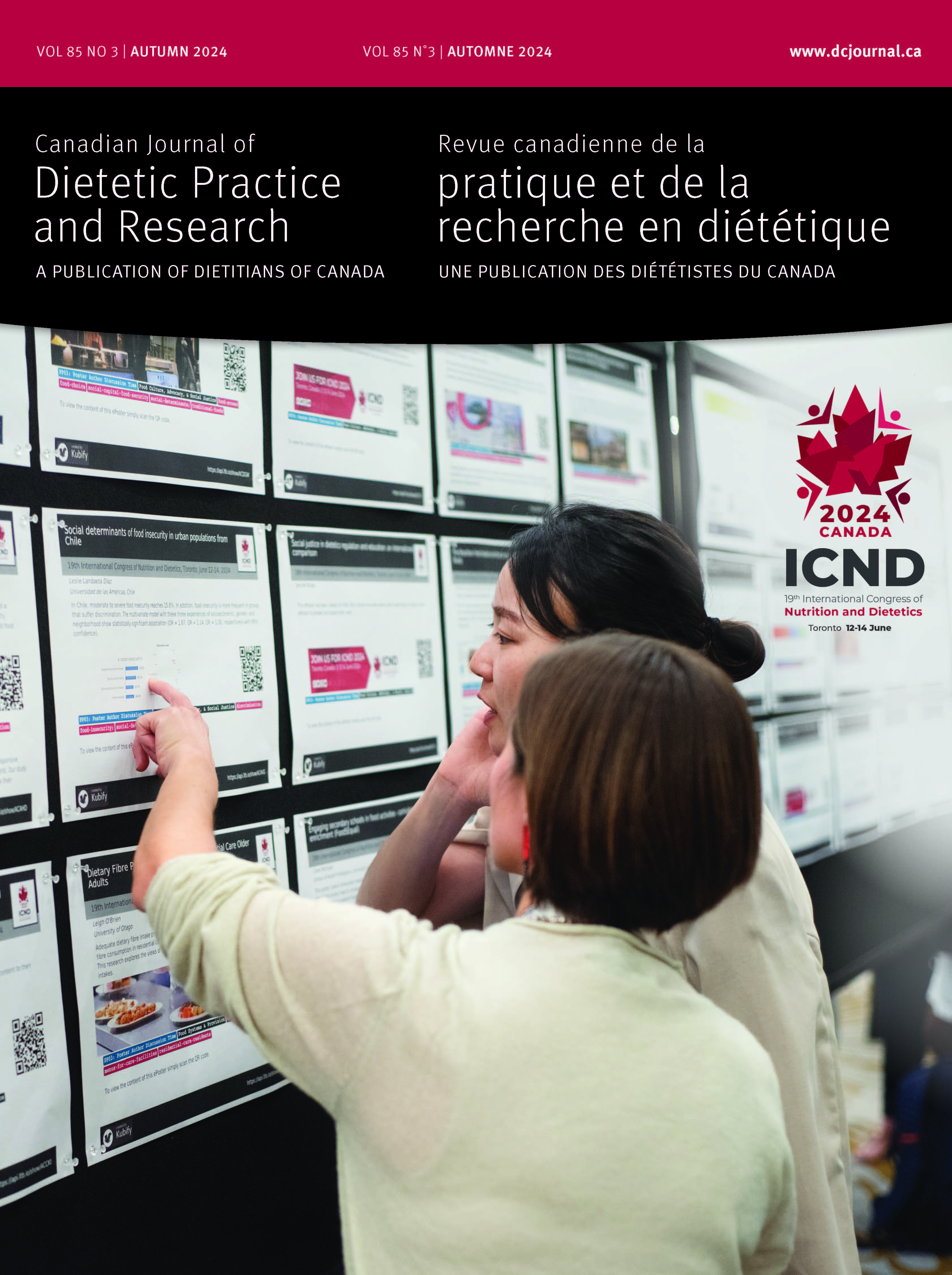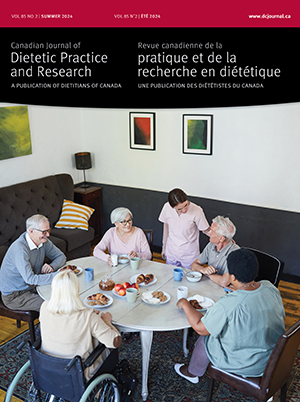Volume 68 • Number 2 • July 2007
Chair’s Message
Editor’s Message
Research
Purpose: How Canadian dietitians define and use non-dieting and size acceptance approaches (SAAs) in the context of weight management was explored. Methods: Fifteen focus groups with 104 dietitians were conducted in seven Canadian cities. Questions were designed to explore participants’ understanding and use of non-dieting and SAAs, including counselling goals, techniques, and outcome measures. Sessions were tape-recorded, transcribed verbatim, coded, and analyzed using qualitative methods. Results: Participants generally agreed that non-dieting involves promoting healthy lifestyles and avoiding restrictive diets. Participants also agreed that size acceptance means accepting all body shapes and sizes and promoting comfort with one's body. Many dietitians said they use size acceptance only with appropriate clients, most often with those who are lighter or without other health risks. Others said that size acceptance, by definition, is appropriate for everyone. Opinions varied about the appropriateness of teaching portion sizes or using meal plans, and whether weight loss could be a goal of non-dieting and SAAs. Conclusions: Views on the usefulness of non-dieting and size acceptance strategies in weight management counselling were related, at least partially, to the different understanding that dietitians had of these approaches. Terminology needs to be clarified when we speak about non-dieting and SAAs. The varied understanding about these concepts should help dietitians reflect on their own perspectives and practice.
Purpose: The degree of food insecurity and dietary intake was examined in adult Colombians who are new immigrants to Canada and use a food bank. Methods: In-person surveys were conducted on a convenience sample of 77 adult Colombian immigrant food bank users in London, Ontario. Degree of food insecurity was measured by the Radimer/Cornell questionnaire, food intakes by 24-hour recall, sociodemographics, and questionnaires about changes in dietary patterns before and after immigration. Results: Thirty-six men and 41 women participated in the study. Despite being highly educated, all respondents had experienced some form of food insecurity within the previous 30 days. The degree of food insecurity seems to be inversely associated with income and length of residency in Canada. Total daily energy intake was low, with a mean value of 1,568.3 ± 606.0 kcal (6,217.5 ± 2,336.4 kJ). In particular, a large proportion of participants consumed a diet low in fruits and vegetables (73%) and milk and dairy products (58%). Conclusions: Colombian immigrant food bank users new to Canada experience various degrees of food insecurity, which is associated with inadequate food intake. Interventions are needed to assist this population with adapting to society while concurrently sustaining healthy eating patterns.
Perspectives in Practice
The Hamilton Health Service Organization Nutrition Program integrates nine registered dietitians (RDs) into the offices of 80 family physicians (FPs) at 50 sites in Hamilton, Ontario. The program is based on a shared care model, in which FPs and RDs work collaboratively to provide nutrition services aimed at prevention, treatment, and management of nutrition-related problems. In addition to their clinical role, dietitians in the program are involved in health promotion, disease prevention and early intervention strategies, interdisciplinary collaboration, building links with community services, and research. The RDs’ specialized knowledge, skills, and experience allow them to provide a wide range of services that complement and augment those of the FP. This model is consistent with Canadian health care reform recommendations and offers significant benefits for both health care providers and consumers.
Although nutrition risk is prevalent in Canadian older adults, the process of screening must be considered before nationwide programs can be recommended. A process evaluation of the Bringing Nutrition Screening to Seniors in Canada demonstration project was completed. Through the use of the 15-item Seniors in the Community: Risk Evaluation for Eating and Nutrition (SCREEN©) questionnaire, risk was identified in convenience samples of 1,196 community-living older adults recruited from five Canadian communities. All at-risk participants were offered referrals to community resources. Telephone follow-up of at-risk participants occurred after screening. Telephone interviews with screening administrators and older adults revealed screening benefits and challenges. Nutrition risk occurred in 38.9% of the sample. Most participants found screening helpful. Among the at-risk group (n=465), 39% accepted referrals for additional services. Older adults provided several reasons for refusing referrals, including denial of risk. Dietitian services were an identified gap, as were prevention-level resources. Nutrition risk is prevalent and older adults can benefit from screening. Training, ongoing support, and prioritization (policy, time, and money) are needed for sustainable screening programs. Before implementation of a nationwide screening program, sufficient and appropriate community resources are required, as is a national strategy for screening older adults.
This article outlines the processes undertaken to revise Canada's Food Guide and shares the updated science that underpins the dietary pattern. The Dietary Reference Intakes provide updated nutrient requirement values and better tools for dietary assessment and planning. Alignment with this updated science was an important component of defining and communicating accurate dietary guidance for Canada. Ensuring that stakeholders had access to the updated review of requirements led to the development of the text Dietary Reference Intakes: The Essential Guide to Nutrient Requirements. Equally important was ensuring that stakeholders were provided opportunity to influence the approach taken to giving dietary guidance, both content and the elements of the final package. A combination of research, consultation and expert advice guided the process to the release of Eating Well with Canada's Food Guide(2007).
Report
Purpose: Texture-modified diets offered in long-term care (LTC) facilities are often prepared from the regular menu, planned using Canada's Food Guide to Healthy Eating. The appropriateness of protein levels of puréed diets in LTC facilities was determined. Methods: Protein content was measured in 29 duplicate diets, collected from 20 urban LTC facilities in Saskatchewan (SK) and Ontario (ON). Mealtime puréed food intakes of 20 LTC residents were assessed. The target protein levels were calculated as estimated average requirements plus one or two standard deviations of intake, thus allowing for moderate (16%) or low (2.5%) risk of inadequacy, respectively. Results: The duplicate diets provided 57.9 ± 7.9 and 85.4 ± 31.1 g/day of protein in SK and ON, respectively. Protein intake of SK LTC residents consuming puréed food averaged 54 ± 19 g/day. Only 43% of the SK puréed diets provided more than 59 g/day of protein and none provided more than 78 g/day; in contrast, 87% and 40% of ON puréed diets provided more than 59 and 78 g/day of protein, respectively. Conclusions: In-house prepared puréed diets do not consistently provide sufficient protein levels to ensure a low risk of inadequacy for the LTC residents consuming these diets.
Purpose: Osteoporosis affects 1.4 million Canadians. Maximizing bone mass by age 30 may reduce this risk. Because calcium intake and body weight are both associated with bone mass, and many Canadian women report that they obtain nutrition information from magazines, we compared the frequency of calcium and body weight messages in Chatelaine and Flare, Canadian magazines for mature versus younger women, respectively. Methods: Using keywords, we identified relevant advertisements and articles in all issues of Chatelaine and Flare for 2000 to 2001. Data were analyzed using paired t-tests and Wilcoxon signed-rank sum tests. Results: Chatelaine had more calcium and weight messages per 100 pages than did Flare (significant only for calcium, p ≤0.0001). Within Chatelaine, there were no significant differences between the frequency of calcium and weight messages; however, almost 90% of Flare's messages focused on weight (p ≤0.0001), with only eight messages in two years addressing calcium. Conclusions: Magazines with limited calcium and many weight messages inadvertently promote a lifestyle that may increase the risk for osteoporosis. The opportunity exists to provide improved calcium and osteoporosis coverage for women at the prime age for maximizing bone density. Awareness of information gaps may help dietitians strategize in promoting nutrition messages to women.
Purpose: The child care setting can help preschoolers develop healthy eating habits. Establishing such habits may increase preschoolers’ likelihood of carrying them into adulthood, which can decrease the risk of nutrition-related chronic diseases. Challenges in supporting preschoolers’ healthy eating were investigated among child care staff. Methods: Three focus group interviews were conducted with 29 child care staff members. Audiotapes of the sessions were transcribed. Results: Several themes were identified from the analysis of the transcripts. An intrapersonal (individual) factor was children's picky eating. Interpersonal factors (interactions) included perceptions that parents do not encourage their children to eat in a healthy way, and that child care staff's use of practices were inconsistent with health professional recommendations. Physical environment factors included perceptions that healthy food was not accessible at child care centres and that children have unhealthy food at home. Conclusions: Program planners and health professionals can develop and implement strategies to overcome some of the identified challenges to supporting preschoolers’ healthy eating.










